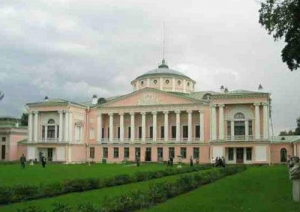Moskau +7-495-505-63-25
Sankt Petersburg +7-812-309-57-60
Ostankino Anwesen-Museum
Excursions with Ostankino Estate
1-Ostankinskaya Str., 5

Ostankino Estate located in the northern part of the Russian capital is one of the survived architectural monuments of the 18th century.
First records of the estate date back to the middle of the 16th century when Ostankino was the place where the Shchelkalovis' estate with a small wooden church was located. In 1620 tsar Mikhail Fyodorovitch presented Ostankino to boyar I. Cherkassky (representative of the titled or non-titled senior nobility and aristocracy). The family of Cherkassky owned the estate till 1743, and then it passed into the hands of the Sheremetyev family.
The golden age of Ostankino Estate started at the end of the 18th century, when Count N. Sheremetyev, the wealthy patron of art, became its owner. Sheremetyev was very fond of theater. He decided to make Ostankino his summer residence and move the theater troupe from Kuskovo. To realize his idea, Sheremetyev ordered to put up the palace-theater in Ostankino.
The classicism-styled palace was erected by serf architects A. Mironov and P. Argunov. And the palacle was designed by Brenna, Kamporezi, and Starov. The construction works lasted from 1792 till 1798. The main facade of the palace was decorated with magnificent six-columned portico of Corinthian order. Another facade, facing the park, was adorned with ten-columned logia of Ionic order. The outside walls of the palace were decorated with bas-relieves by sculptors F. Gordeev and G. Zamaraev. The most attractive part of the palace was the theater hall that could be transformed into the dancing hall. Covered galleries connected the hall with Italian and Egyptian pavilions that were used for both solemn receptions and theater performances. The theater hall is still used for chamber concerts and old operas.
Interiors of the palace are both elegant and simple. The majority of interior decorations are made of wood imitating marble, bronze, alabaster and other materials. The gilded elements are remarkable for their artistic perfection. The walls of Italian pavilion are covered with carved gilded panels. The ornamented parquet floor is made of rare and precious kinds of wood, such as rosewood, palm-tree, ebony, walnut, mahogany, Karelian birch, and so forth. The walls of the palace halls are covered with damask, satin and velvet. The painted plafonds on the ceilings of the palace halls make them look elegant and luxurious.
Ostankino Theater is the only theater in Russia where the 18th-century stage units, including the stage, auditorium, make-up rooms and engine-room equipment are preserved. The acoustics in Ostankino hall is the best in Moscow.
The oldest monument preserved on the territory of Ostankino Estate is the Trinity Life Church with nine-tiered icon-stand put up at the end of the 17th century. The church with five cupolas is made of red bricks decorated with white carved stone and multicolored tiles.
Count N. Sheremetyev died in 1801, and after his death the estate was abandoned. After the October Revolution the estate was nationalized and turned into museum that was called «The Palace-Museum of Serfs' Creation Work». In 1992 the museum was renamed «Museum-Estate Ostankino». It boasts the collection of old Russian icons and wooden sculpture of the end of the 15th century-the beginning of the 20th century, the gathering of furniture of the end of the 14th century-the 19th century (including gilded furniture of the 18th century that was made especially for the palace), collections of paintings and graphics. The collection of lighting devices of the end of the 15th-the beginning of the 20th century deserves special attention. It boasts unique lamps and repetition work examples.
Annually Ostankino Museum-Estate becomes the place of Sheremetyev Seasons festival. The goal of the festival is to present old opera masterpieces to modern public.
Hotels in der Nähe
Cosmos
Mira Pr., 150
Das Hotel Kosmos befindet sich in einem der schönsten und okologisch gesundesten Bezirke der Stadt Moskau. Durch die
ab 0
pro Nacht
Tourist
17 Selskokhozyaistvennaya St.
Das Hotel Tourist ist ein echter Hotelkomplex, der aus 6 fünfstöckigen Gebäude besteht. Dieses 3-Sterne Hotel Tourist
ab 0
pro Nacht
Baikal
15/1 Selskohozyaystvennaya St.
The Baikal hotel complex was established on the basis of the Baikal hotel built in 1976. The first building of the
ab 0
pro Nacht
Zvezdnaya
3 Argunovskaya St.
The Zvezdnaya hotel is located in a green area in the North-Eastern part of Moscow, near the Ostankino Television
ab 0
pro Nacht
Business-Tourist Hotel
17 Selskokhozyaistvennaya St.
The Business-Tourist hotel is conveniently located in a quiet green area in the North-East of Moscow. Not far from
ab 0
pro Nacht
Sehenswürdigkeiten von Moskau
- Monuments
- Attractions











